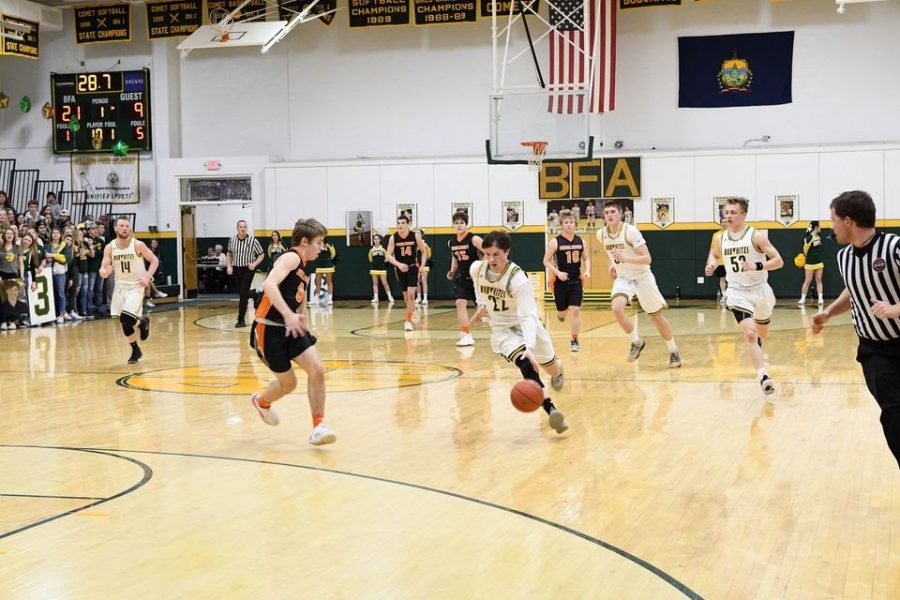The Fate of Winter Sports
The 2019-2020 Bobwhites, led by Ben Archembault, bring the ball up the court with the stands packed behind them. Photo Credit: Bobwhite Basketball, Facebook
October 19, 2020
Covid-19 brought a lot of change to the fall sports season. According to the Vermont Principals’ Association fall sports guidelines, shortened schedules, wearing masks, and the changing of some rules, such as the integration of 7-on-7 football, are some of the adjustments made for a safe sports season. However, the winter sports season brings a whole new challenge: indoor competition.
The aspect of playing sports indoors is discouraged on the CDC website, www.cdc.gov, which states “participation in outdoor activities [is preferred] over indoor activities.” Although this may not be a problem for the skiers and snowboarders of the world, basketball, hockey, and other sports require indoor access to practice and play their games.
“Our goal at the [Vermont Principals’ Association] is for every sport to have something this winter,” said Jay Nichols, Executive Director of the VPA. “But we realize that with some sports, that may not be able to happen.”
Nichols said that some winter sports have serious risk factors that weren’t encountered in the fall. “The biggest concern with inside sports is the lack of fresh air. When you’re outside, there’s less transmission…[The governor’s mask mandate] helps mitigate that concern that people have,” he said.
The sports that are at the biggest risk of being put off are wrestling and track and field. Nichols said, “With wrestling, people are exerting lots of physical energy and breathing right into each other’s faces.” Nichols even said that there “may not be any path forward for wrestling.”
For indoor track and field, the problem isn’t about physical exertion, it is more about finding spaces to practice and hold events. “Indoor track and field is also a concern. That’s more because there’s really no place to practice. The colleges that are usually hosting the events are not allowing those events due to Covid transmission,” said Nichols. “The good thing about track and field is that those athletes have their regular season in the spring, whereas wrestling is more of a concern because that’s the only time we have wrestling,” said Nichols.
As for basketball and hockey, there are options to make the games safer without taking away from the play. Because basketball is the most popular sport in the state, according to Nichols, it creates an opportunity where teams in the same region can play each other, restricting travel and transmission throughout the state of Vermont. As for hockey, there aren’t as many teams, so that may not be a viable option. Along with limited travel, Nichols said, “maybe there’s a path forward where there are games, but there are no spectators, just the players playing.” While this may be a nightmare for some parents out there, this certainly won’t affect the play of the games.
Nichols also suggested a way to incorporate technology into the way sports compete. “In competitions such as dance and cheer, there may be a way where teams can videotape their performances and submit them to the judges where they can judge and score them. These performances could be streamed to parents as well,” he said.
“I just want to get out there and play basketball,” said Justin Brown (‘22). While winter athletes may be nervous about what could happen to their season, the VPA is working diligently to make sure that student-athletes will have an opportunity to play this winter.
“Ultimately the governor and the department of health will make any final decisions, but we’re going to be recommending to have sports as best as we can because we think, for many kids, the most important thing for them that keeps them involved is extracurriculars,” said Nichols.

